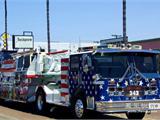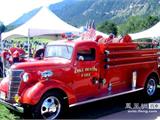The fault of the torque converter in the small sprinkler truck causes vehicle shaking and the secret to making car parts last longer.
For vehicles with active transmission equipment, a lock-up clutch failure can have a significant impact on the vehicle. Common failures of the lock-up clutch include: inability to engage, inability to disengage, poor engagement, and slipping. The symptoms of these failures are varied, so it is important to understand its working principles, characteristics, and methods for analyzing failures. A 1996 Ford Windstar was experiencing vibrations at medium and high speeds, giving the sensation of engine shaking similar to when the car is stationary. According to the owner, this issue had been repaired multiple times at other repair shops, with numerous engine parts replaced, but the fault remained unresolved.
First, a road test was conducted where the vehicle experienced irregular vibrations between 40-80 km/h. An inspection of the engine revealed no faults. Considering other factors might be responsible, a computer diagnostic tool was used to retrieve data streams. It was found that when the lock-up clutch (TCC) engaged, especially between 40%-60%, the vehicle would vibrate. This determined that the fault was due to poor TCC engagement. But what part caused the poor engagement? The fault could lie in either the electronic control, hydraulic, or mechanical systems. There are also special circumstances such as when the throttle is closed, brakes are applied, during sudden acceleration or deceleration, gear shifting, oil temperature below 60℃ or too high, and when the gear is in third or lower, as the lock-up clutch does not engage during these times.
The engagement and disengagement of the lock-up clutch are controlled by the computer (PCM) through the TCC solenoid valve. The computer analyzes signals from the throttle position sensor, vehicle speed sensor, turbine shaft sensor, gear position, shift time, and brake switch, providing a duty cycle signal to the TCC solenoid valve, adjusting its opening to control the clutch's action. To monitor the TCC's operation, the computer uses the difference between the engine's RPM and the turbine shaft (input shaft) RPM. When the lock-up clutch is not working, the engine RPM should be greater than the turbine shaft RPM by 200-300 r/min; during the process of TCC engagement, the RPM difference should gradually decrease; when the TCC is fully engaged, the RPM difference should be basically zero. Therefore, the status and degree of the clutch's operation can be determined by observing the difference between the engine RPM and the turbine RPM (input shaft RPM). For some faults where the TCC cannot engage or disengage, a transmission diagnostic tool (a device that can manually control the solenoid valve) can be connected to disconnect the computer's control over the transmission and manually control the clutch solenoid valve to determine whether the fault lies in the control section or the execution section. If the fault persists when manually controlling the clutch solenoid valve, it indicates that there is no problem with the electronic control section. If the fault lies in the electronic control section, first check if the signals provided by the sensors affecting the TCC's work are normal, then check if the PCM can accurately operate according to the sensor signals, and finally check the connection of the wires.
For hydraulic system faults, pressure measurements can be taken to make judgments. The vehicle's transmission was subjected to an oil pressure test during the road test. No fluctuations or abnormalities in oil pressure were detected when the TCC engaged and caused vibrations. To further judge whether there was a fault in the hydraulic section of the transmission, the valve body was removed and a test template installed, using compressed air for testing. The results showed that the various hydraulic valves and valve body oil passages of the TCC worked well, largely eliminating the possibility of a hydraulic system fault.
As for the mechanical section, since it cannot be disassembled for analysis, faults in other areas must be ruled out to determine the cause. Through the above tests and analyses, it was judged that the fault could only be in the mechanical section, specifically the torque converter lock-up clutch.
Here, we remind all repair personnel that since the torque converter cannot be disassembled, attention should be paid to cleaning issues when repairing the transmission to prevent foreign objects from entering and damaging the torque converter and lock-up clutch. For torque converters with drain plugs, when the oil has deteriorated, open the drain plug and flush repeatedly with new oil; for those without drain plugs, use the method of reversing high-pressure air for cleaning.
"Longevity" Tip One: Avoid Heat
An engine piston overheating can easily lead to melting and cylinder seizure; rubber seals, V-belts, tires, etc., can prematurely age, lose performance, and reduce their lifespan; generator and regulator coils overheating can easily damage them beyond repair.
"Longevity" Tip Two: Avoid Dirt
If components like fuel filters, oil filters, air filters, hydraulic oil filters, and various filter nets get too dirty, it will result in poorer filtration effects. Radiator fins, fins on water-cooled engine blocks and heads, cooler fins, etc., getting too dirty can lead to poor heat dissipation and excessive temperatures.
"Longevity" Tip Three: Avoid Reversal
Engine cylinder head gaskets should not be installed upside down, otherwise they will wear out prematurely; engine fan blades should not be installed backward; for herringbone tread tires, after installation, the ground contact marks should point the herringbone tips backward.
"Longevity" Tip Four: Avoid Missing Parts
Engine valve locks should be installed in pairs; if omitted or missing, it can lead to valve control loss and piston damage; for anti-loosening devices like cotter pins, locking screws, safety clips, or spring washers on engine connecting rod bolts, flywheel bolts, and drive shaft bolts, if omitted, serious problems may occur during use; if the oil nozzle used to lubricate gears in the timing gear chamber of the engine is omitted, severe oil leakage can occur.
"Longevity" Tip Five: Avoid Oil Contamination
Dry-type paper elements in the engine air filter, if contaminated with oil, can easily cause rich mixtures to be drawn into the cylinders, resulting in insufficient air, increased fuel consumption, and reduced engine power; if V-belts get contaminated with oil, it will accelerate their aging; brake shoes, dry clutches friction plates, brake bands, etc., if contaminated with oil, can endanger driving safety. Tire rubber is highly sensitive to oil corrosion; contact with oil can soften or peel the rubber.
The content above is jointly released by the Official Website of Sanitation Garbage Trucks (http://www.clwlu.com/)|www_clwlu_com and Garbage Truck Manufacturers (http://www.clwwcw.com/)|www_clwwcw_com. For more information: Dongfeng crane prices, reasons for oil on spark plugs in Fukang cars, common failures of NSK bearings in sanitation sprinkler trucks, and prices under 200,000 yuan.



